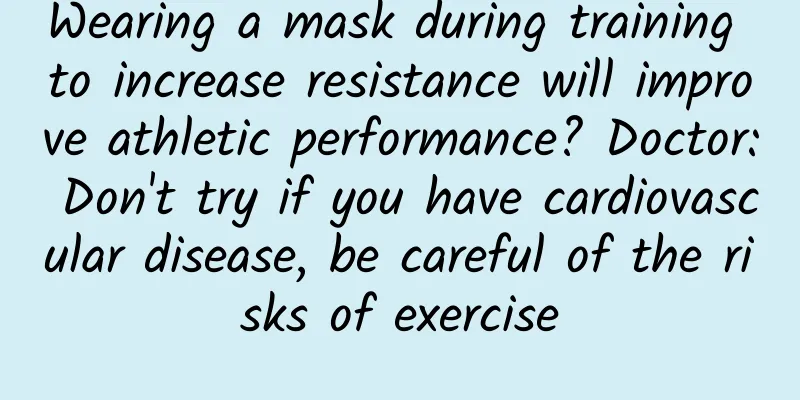Wearing a mask during training to increase resistance will improve athletic performance? Doctor: Don't try if you have cardiovascular disease, be careful of the risks of exercise

|
To fight against the new coronavirus disease (COVID-19, hereinafter referred to as Wuhan pneumonia), you don’t have to just stay at home and do nothing! This is an extraordinary period of epidemic prevention. Many people are afraid of being infected by going to the gym, while some people hope to have an extra layer of protection when exercising, and even wear masks when doing outdoor sports. Recently, there have been expedient measures such as conscripts in Chenggongling wearing masks while jogging and some secondary schools wearing masks during physical education classes. If we put aside the compromise measures for epidemic prevention, some people believe that wearing a mask while exercising can increase the resistance during inhalation, increase the difficulty during training, and thus improve athletic performance. Is this true? Let’s hear what the rehabilitation physician has to say. Professional athletes use "altitude training masks" to train their respiratory muscles Lin Xingqing, attending physician of the Rehabilitation Department of Linkou Chang Gung Memorial Hospital, said that some more professional sports enthusiasts may know that there is a kind of mask called "elevation training mask". The sides of the mask can fit the face tightly to prevent air leakage, and the front end has an air intake valve to control the air flow during inhalation, increasing the resistance during breathing and achieving the purpose of training the respiratory muscles. The original hope of the mask was to simulate training in high-altitude, low-oxygen environments. Due to lack of oxygen at high altitudes, the oxygen content in the body's blood is lower. As long as you adapt long enough, the number of red blood cells in the blood and the efficiency of cells in utilizing oxygen should increase. These changes caused by adapting to the environment will help athletic performance. However, training in an oxygen-deficient environment often fails to achieve the desired training intensity, and the result may not necessarily allow athletes to perform better. Study: Wearing an "altitude training mask" to train does not increase maximum oxygen uptake after exercise According to the American Council on Exercise (ACE), 20 minutes of high-intensity flywheel training twice a week for a total of six weeks while wearing a mask did not change lung function or hemoglobin levels. In fact, the decrease in blood oxygen while wearing a mask was only slightly (2%). Recent studies have shown that wearing an "altitude training mask" does not increase the maximum oxygen uptake (the limit of cardiopulmonary function) after exercise compared to not wearing it. However, training with a mask may help delay the anaerobic threshold (the point during exercise when lactic acid begins to accumulate), as well as the ability to produce force at the anaerobic threshold, when cardiorespiratory fitness can no longer increase with exercise intensity. As for training with an "altitude training mask", can it increase strength performance? Dr. Lin Xingqing said that although, in theory, training in an oxygen-deficient environment can increase muscle hypertrophy and strength, current research has not been able to confirm that training with an "altitude training mask" can achieve such an effect. Some studies have even found that wearing an "altitude training mask" during squats and push-ups will slow down the movements and reduce training effectiveness in the long run. Fighting athletes adapt to the inability to breathe smoothly during competition and use "altitude training masks" to simulate training Although the evidence for improving aerobic or resistance exercise performance is weak, some competitive martial artists still perform such training, one possible benefit being that it helps them adapt to the short breathing conditions of close-quarters grappling during competition. In Jiu-Jitsu and MMA, the neck is often strangled or the mouth and nose are covered during a fight. Therefore, the "Altitude Training Mask" can simulate this state of resistance in breathing. If you have cardiovascular disease, don't try to wear a mask when exercising. Be careful of the risks of exercise. Even the best-fitting high-altitude training masks cannot be proven to directly promote maximum aerobic or resistance exercise performance. Ordinary surgical masks only allow some air to enter from the front, so there is certainly no way to achieve the desired effect. If you have cardiovascular disease and want to try wearing a mask while exercising, it is best to discuss it with a physician with cardiopulmonary function or exercise-related expertise before making a decision to avoid the risks of other exercises caused by increased respiratory resistance. |
Recommend
Abortion is no small matter, and you need to be aware of these three misunderstandings!
As young people's views on human nature becom...
What is the reason for the sudden increase in menstrual flow and bright red color?
What is the reason for the sudden increase in men...
How much does it cost to treat pelvic peritonitis?
Female friends are very familiar with pelvic peri...
Three situations that can easily be overlooked and lead to ectopic pregnancy
Ectopic pregnancy is a common and dangerous acute...
How to care for amenorrhea
How should we care for amenorrhea? Amenorrhea is ...
What are the treatments for cervicitis in women? 4 folk remedies for cervicitis you can try
The first thing that causes cervicitis is that th...
What are the three main causes of cervical erosion?
In recent years, the incidence of cervical erosio...
Young woman took diet pills and ended up with chronic renal failure
If you take diet pills indiscriminately, be caref...
Early symptoms and treatment of congenital absence of vagina
Experts say that congenital absence of vagina is ...
Chang'e, please don't laugh at my magnanimity! 3 Yoga Tips to Reduce Belly Fat
During the Mid-Autumn Festival holiday, people ea...
The most important symptoms of vaginitis
Vaginitis is a common disease in life. After suff...
How to prevent cervical hypertrophy in time
The high incidence of cervical hypertrophy is ver...
Further discussion on precautions after abortion
I believe everyone should be familiar with aborti...
Can bacterial vaginosis be transmitted to other people?
In recent years, due to poor hygiene, the rate of...
Sports girls, look here! Eating breakfast like this can help you lose weight
According to the British Daily Mail, most British...









